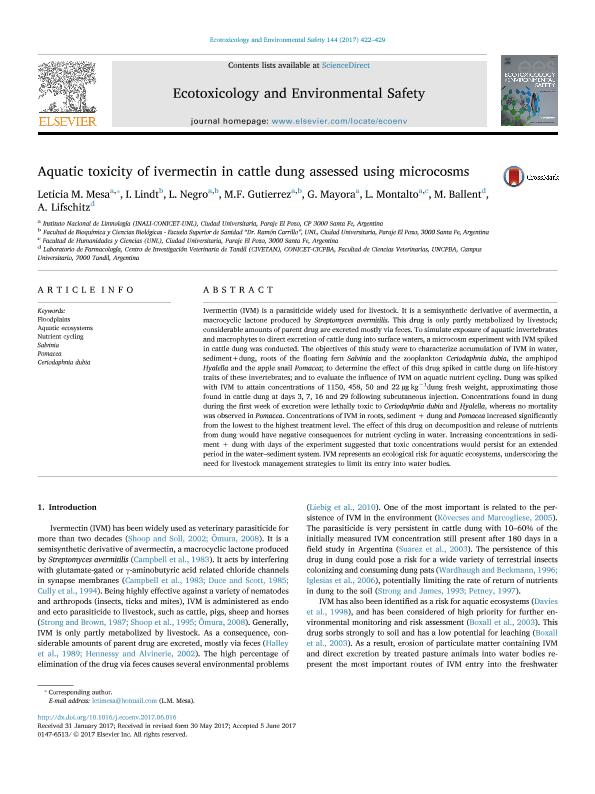Artículo
Aquatic toxicity of ivermectin in cattle dung assessed using microcosms
Mesa, Leticia Mariana ; Lindt, I.; Negro, Carlos Leandro
; Lindt, I.; Negro, Carlos Leandro ; Gutierrez, Marìa Florencia
; Gutierrez, Marìa Florencia ; Mayora, Gisela Paola
; Mayora, Gisela Paola ; Montalto, Luciana
; Montalto, Luciana ; Ballent, Mariana
; Ballent, Mariana ; Lifschitz, Adrian Luis
; Lifschitz, Adrian Luis
 ; Lindt, I.; Negro, Carlos Leandro
; Lindt, I.; Negro, Carlos Leandro ; Gutierrez, Marìa Florencia
; Gutierrez, Marìa Florencia ; Mayora, Gisela Paola
; Mayora, Gisela Paola ; Montalto, Luciana
; Montalto, Luciana ; Ballent, Mariana
; Ballent, Mariana ; Lifschitz, Adrian Luis
; Lifschitz, Adrian Luis
Fecha de publicación:
10/2017
Editorial:
Academic Press Inc Elsevier Science
Revista:
Ecotoxicology and Environmental Safety
ISSN:
0147-6513
Idioma:
Inglés
Tipo de recurso:
Artículo publicado
Clasificación temática:
Resumen
Ivermectin (IVM) is a parasiticide widely used for livestock. It is a semisynthetic derivative of avermectin, a macrocyclic lactone produced by Streptomyces avermitilis. This drug is only partly metabolized by livestock; considerable amounts of parent drug are excreted mostly via feces. To simulate exposure of aquatic invertebrates and macrophytes to direct excretion of cattle dung into surface waters, a microcosm experiment with IVM spiked in cattle dung was conducted. The objectives of this study were to characterize accumulation of IVM in water, sediment+dung, roots of the floating fern Salvinia and the zooplankton Ceriodaphnia dubia, the amphipod Hyalella and the apple snail Pomacea; to determine the effect of this drug spiked in cattle dung on life-history traits of these invertebrates; and to evaluate the influence of IVM on aquatic nutrient cycling. Dung was spiked with IVM to attain concentrations of 1150, 458, 50 and 22 µg kg−1dung fresh weight, approximating those found in cattle dung at days 3, 7, 16 and 29 following subcutaneous injection. Concentrations found in dung during the first week of excretion were lethally toxic to Ceriodaphnia dubia and Hyalella, whereas no mortality was observed in Pomacea. Concentrations of IVM in roots, sediment + dung and Pomacea increased significantly from the lowest to the highest treatment level. The effect of this drug on decomposition and release of nutrients from dung would have negative consequences for nutrient cycling in water. Increasing concentrations in sediment + dung with days of the experiment suggested that toxic concentrations would persist for an extended period in the water–sediment system. IVM represents an ecological risk for aquatic ecosystems, underscoring the need for livestock management strategies to limit its entry into water bodies.
Archivos asociados
Licencia
Identificadores
Colecciones
Articulos(CIVETAN)
Articulos de CENTRO DE INVESTIGACION VETERINARIA DE TANDIL
Articulos de CENTRO DE INVESTIGACION VETERINARIA DE TANDIL
Articulos(INALI)
Articulos de INST.NAC.DE LIMNOLOGIA (I)
Articulos de INST.NAC.DE LIMNOLOGIA (I)
Citación
Mesa, Leticia Mariana; Lindt, I.; Negro, Carlos Leandro; Gutierrez, Marìa Florencia; Mayora, Gisela Paola; et al.; Aquatic toxicity of ivermectin in cattle dung assessed using microcosms; Academic Press Inc Elsevier Science; Ecotoxicology and Environmental Safety; 144; 10-2017; 422-429
Compartir
Altmétricas



